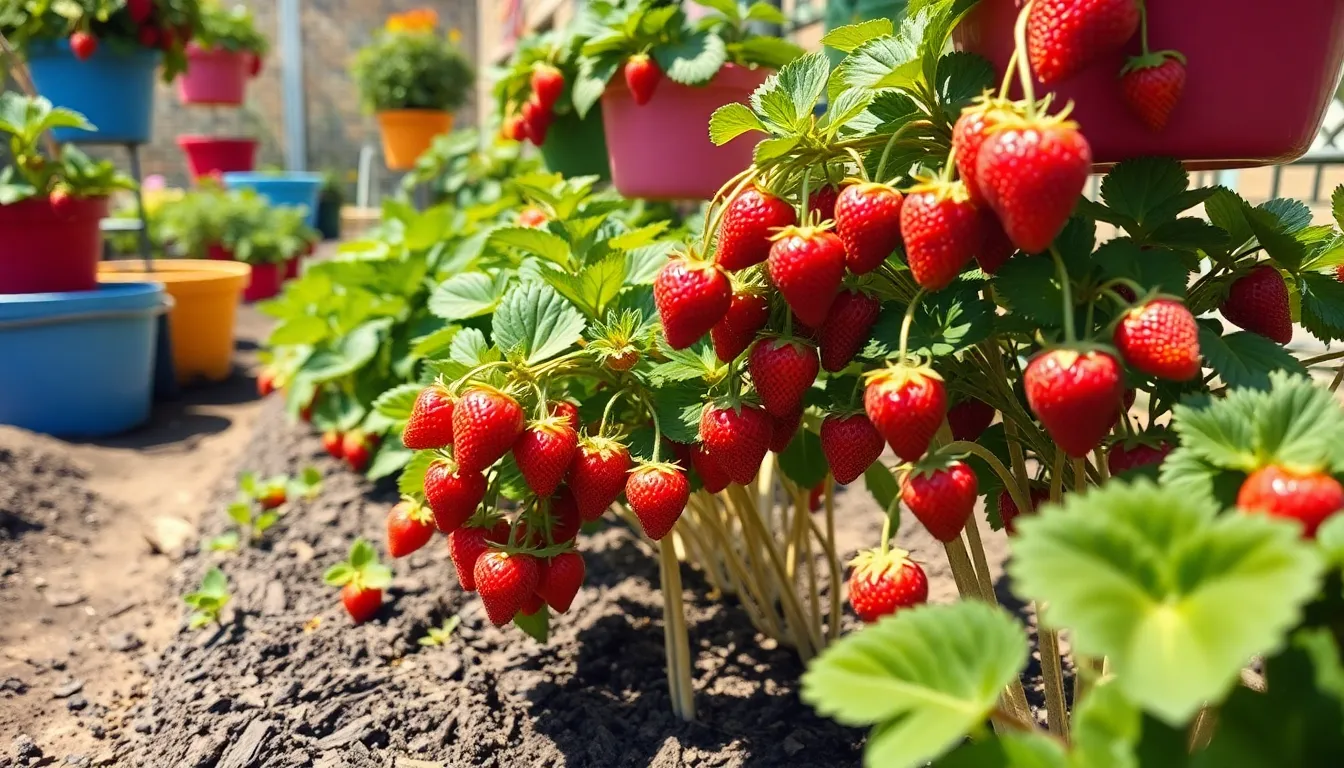Table of Contents
ToggleStrawberries are the delightful jewels of the fruit world, bursting with flavor and sweetness. But have you ever wondered what these vibrant red delights actually grow on? Spoiler alert: it’s not a magic strawberry tree! Instead, these delicious treats sprout from low-growing plants that spread their leafy arms wide, inviting you to enjoy their luscious offerings.
Understanding Strawberry Growth
Strawberries thrive on perennial plants, which means they grow year after year. These plants feature a unique growth habit with runners, also called stolons, spreading horizontally. Runners produce new plants at nodes, making strawberry cultivation efficient.
Soil quality significantly impacts strawberry growth. Well-drained, loamy soil with a pH of 5.5 to 6.8 promotes optimal growth. Organic matter improves fertility and moisture retention in the soil. Regular amendment enhances nutrient levels and ensures healthy plant development.
Sunlight influences fruit production directly. Strawberries require at least six to eight hours of full sun daily. Insufficient sunlight results in lower yields and smaller fruits. Protection from strong winds is also beneficial, as it prevents damage to the fragile flowers and fruits.
Watering practices play an essential role in growing strawberries. Consistent moisture is crucial for fruit development, yet overwatering can lead to root rot. Drip irrigation systems offer optimal water delivery, reducing water waste while preventing foliage from becoming wet.
Harvesting strawberries occurs when fruits achieve a bright red color, indicating ripeness. Careful handling during harvesting prevents damage, and picking should occur during dry weather for best results. Proper storage at a temperature of 32°F to 36°F extends shelf life and maintains freshness.
Fertilization schedules influence the overall health of strawberry plants. Applying fertilizer before planting and again after the first harvest typically yields excellent results. Regular monitoring of nutrient levels ensures that plants receive adequate nourishment throughout their growth cycle.
What Do Strawberries Grow On?

Strawberries grow on robust, low-growing plants that produce fruits in a variety of conditions. Understanding their growth requirements ensures a successful harvest.
Soil Requirements
Soil plays a vital role in the growth of strawberries. Well-drained, loamy soil provides the ideal environment for roots. pH levels between 5.5 and 6.8 create optimal conditions for nutrient absorption. Compacted or heavy clay soil hinders growth and increases the risk of root rot. Organic materials, such as compost, enhance soil structure and fertilization. Regular testing of soil ensures it maintains the necessary nutrient balance.
Container Options
Growing strawberries in containers offers versatility and flexibility. Pots, hanging baskets, and raised beds suit various outdoor or indoor spaces. Drainage holes are crucial to prevent excess moisture, which can damage roots. Choosing containers at least 12 inches in diameter allows ample room for root development. Strawberry-specific planters, designed to maximize space, are also available. Container-grown strawberries can thrive with proper sunlight and watering techniques.
Cultivation Methods
Strawberries thrive through diverse cultivation methods, enhancing their growth potential and fruit quality.
Raised Beds
Raised beds create an optimal environment for strawberry plants. These structures provide excellent soil drainage, reducing the risk of root rot. They also warm up quicker in spring, allowing for an earlier planting season. Spacing plants 12 to 18 inches apart enables good air circulation, which minimizes disease. Utilizing a mix of loamy soil enriched with organic matter fosters robust growth and nutrient uptake. Regular watering and mulching around the plants help maintain moisture levels and suppress weeds, ensuring a productive harvest.
Hydroponics
Hydroponics offers a soilless approach to growing strawberries. This method uses nutrient-rich water solutions that deliver essential minerals directly to the roots. Growers often utilize systems like nutrient film technique (NFT) or deep water culture (DWC) for efficient nutrient absorption. Light exposure can be controlled in indoor settings, promoting year-round production. With careful monitoring of pH and nutrient levels, hydroponically grown strawberries yield high-quality fruit. This method also minimizes pesticide use, contributing to healthier harvests and appealing fruits.
Factors Affecting Strawberry Growth
Several critical factors affect the growth of strawberries. Understanding these components ensures healthy plants and abundant fruit.
Sunlight and Temperature
Sunlight exposure directly influences strawberry production. It thrives in locations receiving at least six to eight hours of sunlight daily. Optimal temperature ranges for growth lie between 60°F and 80°F. During blooming, temperatures near 70°F enhance fruit set. Additionally, excessive heat above 85°F can lead to poor fruit development. Providing adequate sunlight not only supports flowering but also contributes to overall plant vitality.
Watering Practices
Watering practices play a vital role in the health of strawberry plants. Consistent moisture retention is essential for growth, but overwatering can lead to root rot. It’s ideal to provide about one to two inches of water per week, particularly during fruiting stages. Drip irrigation systems help deliver water directly to roots while minimizing excess moisture on foliage. Monitoring soil moisture levels ensures adequate watering without waterlogging. Adjusting watering frequency based on rainfall eases the burden on the plants.
Strawberries are a delightful addition to any garden or container. Understanding the unique growth requirements of these fruits can lead to a bountiful harvest. With the right soil conditions proper sunlight and careful watering practices strawberry plants can thrive and produce sweet juicy berries. Whether grown in traditional beds or innovative hydroponic systems the versatility of strawberries makes them accessible for all types of gardeners. By paying attention to their needs and providing the right care anyone can enjoy the satisfaction of growing their own strawberries.




